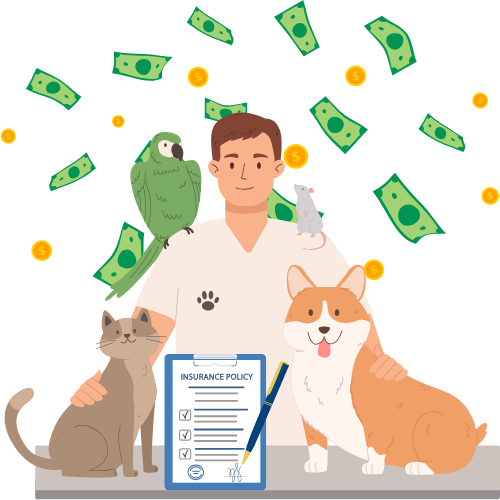Is Pet Insurance a Smart Investment or an Unnecessary Expense?
Key Takeaways
Pet insurance can provide financial security, helping cover unexpected and costly vet bills
Not all conditions are covered: pre-existing conditions and some hereditary issues may be excluded
You pay upfront and get reimbursed, which may be a challenge if you lack immediate funds
Pet insurance can improve access to life-saving treatments, increasing survival rates in emergencies
Veterinary staff benefit, as insured pets are more likely to receive recommended care, reducing emotional strain on veterinarians
Pet insurance costs vary, and while it may provide peace of mind, some owners may pay more in premiums than they would in vet bills
Alternatives exist, such as emergency savings accounts and financial aid programs, for those who can’t afford insurance
There’s no one-size-fits-all answer: each pet owner must weigh the costs, benefits, and available alternatives to make the best choice for their pet’s healthcare needs
Did you know what insurance for pets and animals began around 1890 in Sweden covering livestock and horses. In the United States, pet insurance began with none other than Lassie the famous TV collie in 1982. It wasn’t until 1997 that plans for dogs, cats, and other common pets become more widely available. Pet insurance is now a rapidly growing industry, with more pet owners considering it as a way to manage unexpected veterinary costs.
But is it the right choice for you? Understanding the benefits, limitations, and alternatives to pet insurance can help you make an informed decision about your pet’s healthcare and financial future.
The Pros of Pet Insurance

1. Financial Protection Against High Vet Bills
Vet expenses can be overwhelming. In 2024, the largest pet insurance claim for a dog-related illness was $60,882, while for cats, it was $40,057. With the right coverage, pet insurance can significantly reduce these out-of-pocket expenses.
2. Freedom to Choose Your Vet
Unlike human health insurance, pet insurance usually allows you to visit any licensed veterinarian without network restrictions.
3. Encourages Preventative Care
Studies show that insured pet owners are more likely to schedule routine check-ups and follow veterinarian recommendations, which improves long-term pet health.
4. Reduces Veterinary Staff Burnout
The top cause of burnout among veterinary professionals is the emotional toll of seeing pets denied care due to financial constraints. Financial limitations often force pet owners into heartbreaking decisions, affecting veterinary staff morale. Studies reveal that 57% of veterinarians face clients daily who cannot afford necessary treatments. Another study looking into veterinary workplace morale and burnout concluded that “73% of respondents stated that not being able to do the right thing for a patient caused their staff moderate to severe stress and 78% replied that it caused them moderate to severe distress”. Pet insurance alleviates this stress by making life-saving care more accessible, benefiting both pets and their caregivers. In turn, veterinarians experience higher morale, reduced burnout, and a more positive work environment.
5. Increased Survival Rates
A study in Australia found that insured dogs were five times more likely to receive life-saving treatment for bloat than uninsured dogs. Research also shows that pet owners with insurance seek medical care sooner when their pets show early signs of illness.
The Cons of Pet Insurance

1. Not All Conditions Are Covered
Many basic policies only cover accidents, excluding illnesses like cancer unless you purchase a comprehensive plan. Pre-existing conditions are almost never covered.
2. Coverage Limitations
Some plans exclude coverage based on breed, age, or specific hereditary conditions. Pet size and breed can also impact premium costs. Certain exotic pets may not be covered at all. It’s important to research and compare policies to ensure coverage meets your pet’s needs.
3. Cost Considerations
Comprehensive pet insurance plans can be costly, and premiums increase as your pet ages. While insurance provides financial security, there’s a good chance you may spend more on premiums than you would on vet bills over your pet’s lifetime. It also makes sense that the better the coverage, the more expensive the premium. However, that does not mean you should forego insurance. It is critical to acknowledge and understand the true purpose of pet insurance. The main purpose is not to save you money, but rather to serve as a safety net in the case of unexpected costs. It’s also important to realize that we may overestimate the true cost of pet insurance. One survey found that 89% of dog owners overestimate the monthly cost of insurance while 76% of owners overestimate by as much as 3 times the true cost.
4. You Pay Upfront and Get Reimbursed
Unlike human health insurance, where you pay only a copay, pet insurance requires you to pay the full cost upfront and submit a claim for reimbursement. If you lack immediate funds, this can be a major hurdle. According to Emily M. Tincher, DVM, “The challenge of the pet health industry is that many insurance products are most helpful for those who can already afford some level of care.”
5. Potential for Wasted Money
If your pet remains healthy, you might pay thousands in premiums without needing significant coverage. However, the purpose of insurance is financial security, not necessarily savings.
6. Waiting Periods and Claim Rejections
Coverage doesn’t start immediately. Many policies have waiting periods before they take effect, and some exclude specific conditions for a set time after enrollment.
Alternatives

If pet insurance doesn’t seem like the right fit or is unaffordable, here are other ways to manage veterinary expenses:
1. Create a Pet Emergency Savings Fund
Instead of paying premiums, set aside money in a high-yield savings account dedicated to pet healthcare. One recommendation by Kaplan Financial Advisors is to save $5,000 to $10,000 for a pet emergency. If your pet lucks out and has no major unexpected medical expenses in their lifetime, you now have a pot of cash to put towards other necessary expenses. Maybe even your next pet’s medical care?
2. Seek Financial Assistance
Several organizations provide financial aid for pet owners in need. Notable programs include:
Local Animal Shelters and Charities
Tips for Navigating the Options
1. Use Pawlicy Advisor
Pawlicy Advisor, recommended by the American Animal Hospital Association (AAHA), is an independent tool that helps pet owners compare insurance plans based on their pet’s breed, medical needs, and budget. Additionally, speaking with veterinarians and individual insurance companies is crucial to understanding what coverage is best suited for your pet.
2. Request Quotes
Request not just a single quote, but quotes for at least 10 years down the road. Then do some basic math to determine the expected premium cost over a decade of a pet’s life.
3. Research Coverage
Make sure you know what is and what is not covered under any specific plan you are considering.
4. Insure Early
Insure your pets at and early age to prevent claim rejections due to preexisting conditions. Obtaining proper coverage becomes more difficult as pets age, often when they need it the most.
5. Understand Pros and Cons of Add-On Coverage Options
Some add-on coverage plans may seem like a good idea on the surface. Some may in fact be great options for you. However, others may be more costly than beneficial. Make sure you understand the costs and benefits of each add-on option.
The Rising Costs of Veterinary Care and Pet Insurance Trends

Veterinary costs are increasing: Prices have risen by over 60% in the last decade, with a 7.6% increase in the past year alone. This is partly due to the fact veterinary care and medicine is approaching the levels found in human health and medicine.
Few pets are insured: Despite growing awareness, only 4% of U.S. dogs and 1% of cats have insurance. Nearly 1 in 4 owners admit they weren’t aware pet insurance existed. 1 in 5 owners claim they don’t see the value in pet insurance. But by far the biggest reason comes from perceived cost. Nearly half (42%) of uninsured dog owners, for instance, claim the cost of insurance is too high. Keep in mind what was stated earlier: 89% of dog owners overestimate the monthly cost of insurance while 76% of owners overestimating by as much as 3 times the true cost. Therefore, almost half of owners aren’t picking up insurance because the misconception that it is more expensive than it truly is. With more education and outreach, pet insurance may be able to reach more and more responsible pet owners.
Pet insurance is growing fast: Ownership has increased by an average of 20% per year over the last five years. The U.S. pet insurance market saw a 22.1% growth from 2021 to 2022, covering 4.8 million pets.
Market projections: The industry is expected to grow at a 17.5% compound annual rate, reaching a $10 billion market size by 2030.
Final Thoughts: Is Pet Insurance Right for You?
Pet insurance can be a lifesaver in emergencies, but it’s not a one-size-fits-all solution. Consider your pet’s age, breed, medical history, and your financial situation before deciding.
An article on NerdWallet states plainly:
Consider buying pet insurance if:
- Your pet is young and healthy.
- You don’t have enough savings to cover a hefty vet bill.
- Having insurance gives you peace of mind.
Pet insurance may not be worth it if:
- Your pet is a senior or has health problems.
- A big vet bill wouldn’t be a financial hardship for you.
- You’d rather take the risk of an expensive diagnosis than pay for insurance you might never use.
Regardless of whether you choose insurance, it’s crucial to plan ahead for both routine and unexpected veterinary expenses.
For more pet care insights, visit Burnell Pets. Planning now ensures you can always provide the best care for your furry companion when they need it most.
